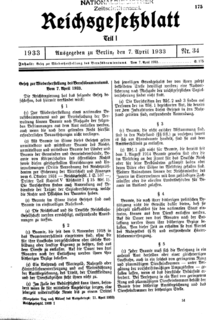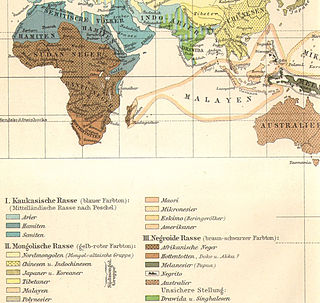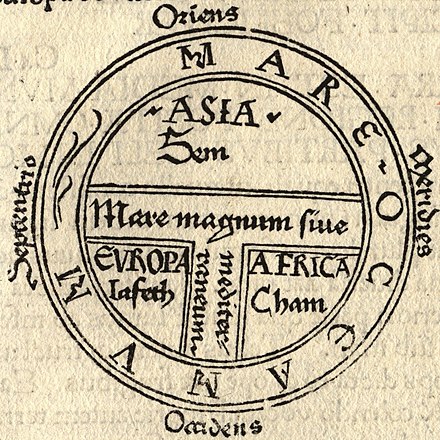Antisemitism is hostility to, prejudice, or discrimination against Jews. A person who holds such positions is called an antisemite. Antisemitism is generally considered to be a form of racism.

The Aryan race is a historical race concept which emerged in the period of the late 19th century and mid-20th century to describe people of Indo-European heritage as a racial grouping.

The racial policy of Nazi Germany was a set of policies and laws implemented in Nazi Germany (1933–45) based on a specific racist doctrine asserting the superiority of the Aryan race, which claimed scientific legitimacy. This was combined with a eugenics programme that aimed for racial hygiene by compulsory sterilization and extermination of those who they saw as Untermenschen ("sub-humans"), which culminated in the Holocaust.

Philo-Semitism or Judeophilia is an interest in, respect for and an appreciation of Jewish people, their history and the influence of Judaism, particularly on the part of a gentile.

Joseph Ernest Renan was a French expert of Semitic languages and civilizations (philology), philosopher, biblical scholar and critic, and historian of religion. He is best known for his influential and pioneering historical works on the origins of Early Christianity, and his political theories, especially concerning nationalism and national identity. Renan is credited as being among the first scholars to advance the now-discredited Khazar theory, which held that Ashkenazi Jews were descendants of the Khazars, Turkic peoples who had adopted Jewish religion and migrated to Western Europe following the collapse of their khanate.

Houston Stewart Chamberlain was a British-born German philosopher who wrote works about political philosophy and natural science; he is described by Michael D. Biddiss, a contributor to the Oxford Dictionary of National Biography, as a "racialist writer". Chamberlain married Eva von Bülow, the daughter of composer Richard Wagner, in December 1908, twenty-five years after Wagner's death.

Essai sur l'inégalité des races humaines is the infamous work of French writer Joseph Arthur, Comte de Gobineau, which argues that there are differences between human races, that civilizations decline and fall when the races are mixed and that the white race is superior. It is today considered to be one of the earliest examples of scientific racism.

Japhetite in Abrahamic religions is an obsolete historical Biblical terminology for race coined in 18th century ethnology and linguistics for the peoples supposedly descended from Japheth, one of the three sons of Noah in the Bible. The other two sons of Noah, Shem and Ham, are the eponymous ancestors of the Semites and the Hamites, respectively.

The Law for the Restoration of the Professional Civil Service, also known as Civil Service Law, Civil Service Restoration Act, and Law to Re-establish the Civil Service, was a law passed by the National Socialist regime of Germany on 7 April 1933, two months after Adolf Hitler had attained power.

Alexandru C. Cuza, also known as A. C. Cuza, was a Romanian far-right politician.

Nazism and race concerns the Nazi Party's adoption and further development of several hypotheses concerning their concept of race. Classifications of human races were made and various measurements of population samples were carried out during the 1930s.

Hans Friedrich Karl Günther was a German writer and eugenicist in the Weimar Republic and the Third Reich. He was also known as Race Günther (Rassengünther) or Race Pope (Rassenpapst). He is considered to have been a major influence on Nazi racialist thought. He taught at the universities of Jena, Berlin, and Freiburg, writing numerous books and essays on racial theory. Günther's Short Ethnology of the German People (1929) was a popular exposition of Nordicism. In May 1930, he was appointed to a new chair of racial theory at Jena. He joined the Nazi Party in 1932 as the only leading racial theorist to join the party before it assumed power in 1933.

Racial antisemitism is prejudice against Jews based on a belief or assertion that Jews constitute a distinct racial or ethnic group that has inherent traits or characteristics that are in some way abhorrent or inherently inferior or otherwise different from that of the rest of society. The abhorrence may be expressed in the form of stereotypes or caricatures. Racial antisemitism may present Jews, as a group, as being a threat in some way to the values or safety of society. Racial antisemitism could be seen as worse than religious antisemitism because for religious antisemites conversion was an option and once converted the 'Jew' was gone. With racial antisemitism a Jew could not get rid of their Jewishness.
The Foundations of the Nineteenth Century is a book by British-born Germanophile Houston Stewart Chamberlain. In the book, Chamberlain advances various racialist and especially völkisch antisemitic theories on how he saw the Aryan race as superior to others, and the Teutonic peoples as a positive force in European civilization and the Jews as a negative one. The book was his best-selling work.

Hamites is a historical Biblical terminology for race coined in 18th century ethnology and linguistics for a division of the human race and the group of related languages these populations spoke. The term was originally used in contrast to the other two proposed divisions of the world – Semites and Japhetites. The appellation Hamitic was applied to the Berber, Cushitic, and Egyptian branches of the Afroasiatic language family, which, together with the Semitic branch, was thus formally labelled "Hamito-Semitic". However, since the three Hamitic branches have not been shown to form an exclusive (monophyletic) phylogenetic unit of their own, separate from other Afroasiatic languages, linguists no longer use the term in this sense. Each of these branches is instead now regarded as an independent subgroup of the larger Afroasiatic family.

The Italian racial laws were a set of laws promulgated by Fascist Italy from 1938 to 1943 to enforce racial discrimination in Italy, directed mainly against the Italian Jews and the native inhabitants of the colonies.

"Aryan" has as its root a term that was used as a self-designation by Indo-Iranian people. The term was used by the Indo-Aryan people of the Vedic period in India as an ethnic label for themselves and later refer to the noble class as well as the geographic region known as Āryāvarta, where Indo-Aryan culture is based. The Iranian people used the term as an ethnic label for themselves in the Avesta scriptures, and the word forms the etymological source of the country name Iran. It was believed in the 19th century that Aryan was also a self-designation used by all Proto-Indo-Europeans, a theory that has now been abandoned. Scholars point out that, even in ancient times, the idea of being an "Aryan" was religious, cultural and linguistic, not racial.

Criticism of the Israeli government, often referred to simply as criticism of Israel, is an ongoing subject of journalistic and scholarly commentary and research within the scope of international relations theory, expressed in terms of political science. Within the scope of global aspirations for a community of nations, Israel has faced international criticism since its declaration of independence in 1948 relating to a variety of topics, both historical and contemporary.
Semitic most commonly refers to the Semitic languages, a name used since the 1770s to refer to the language family currently present in West Asia, North and East Africa, and Malta.
The Khazar hypothesis of Ashkenazi ancestry, often called the "Khazar myth" by its critics, is the hypothesis that Ashkenazi Jews are in large part descended from the Khazars, a multi-ethnic conglomerate of Turkic peoples who formed a semi-nomadic Khanate in the area extending from Eastern Europe to Central Asia. The hypothesis draws on some medieval sources such as the Khazar Correspondence, according to which at some point in the 8th–9th centuries, the ruling elite of the Khazars was said by Judah Halevi and Abraham ibn Daud to have converted to Rabbinic Judaism. The scope of the conversion within the Khazar Khanate remains uncertain: the evidence used to tie the Ashkenazi communities to the Khazars is meager and subject to conflicting interpretations.


















